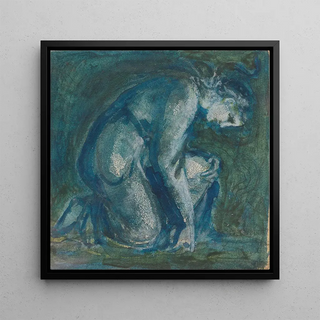A kneeling figure - Sir Edward Coley Burne-Jones

The contemplative solemnity in Une figure agenouillée, revealed by Sir Edward Coley Burne-Jones
The composition features a kneeling silhouette bathed in soft light, where elegant lines and refined drawing characterize the balance between grace and introspection. The muted tones and pearly shades contrast with stronger accents, creating an almost sculptural depth. The technique, faithful to Burne-Jones's Pre-Raphaelite drawing, favors fine lines and a subtle palette to convey a silent and meditative emotion. This painting captures attention through its treatment of volume, the folds of the garment, and the delicate modeling of the face, inviting prolonged contemplation.
Sir Edward Coley Burne-Jones, master of the Pre-Raphaelite movement
Sir Edward Coley Burne-Jones (1833–1898) stands as a central figure of the Pre-Raphaelite movement and late Victorian aesthetics. Influenced by medieval legends and romantic literature, he favors lyrical compositions, a harmonious palette, and a strong sense of decoration. His major works, often devoted to mythological or religious themes, helped renew narrative painting in England and inspired craftsmen and designers of the Arts and Crafts movement. The presence of Une figure agenouillée in his work illustrates his taste for idealized beauty and the tension between spirituality and artistic form.
A decorative acquisition with multiple assets
This art print of Une figure agenouillée naturally fits into a living room, a library, or a bedroom, where its soothing atmosphere encourages reflection and elegance. The art print of Une figure agenouillée offered here respects the delicacy of the original drawing and the chromatic subtleties, providing remarkable fidelity for a contemporary display. In a framed version or on canvas, the painting Une figure agenouillée brings a discreet yet assertive artistic presence; the canvas Une figure agenouillée is particularly suited to both understated spaces and more decorative interiors. Choosing this work means adopting a piece rich in history and aesthetics, ideal for enriching a collection or enhancing interior decoration.

The contemplative solemnity in Une figure agenouillée, revealed by Sir Edward Coley Burne-Jones
The composition features a kneeling silhouette bathed in soft light, where elegant lines and refined drawing characterize the balance between grace and introspection. The muted tones and pearly shades contrast with stronger accents, creating an almost sculptural depth. The technique, faithful to Burne-Jones's Pre-Raphaelite drawing, favors fine lines and a subtle palette to convey a silent and meditative emotion. This painting captures attention through its treatment of volume, the folds of the garment, and the delicate modeling of the face, inviting prolonged contemplation.
Sir Edward Coley Burne-Jones, master of the Pre-Raphaelite movement
Sir Edward Coley Burne-Jones (1833–1898) stands as a central figure of the Pre-Raphaelite movement and late Victorian aesthetics. Influenced by medieval legends and romantic literature, he favors lyrical compositions, a harmonious palette, and a strong sense of decoration. His major works, often devoted to mythological or religious themes, helped renew narrative painting in England and inspired craftsmen and designers of the Arts and Crafts movement. The presence of Une figure agenouillée in his work illustrates his taste for idealized beauty and the tension between spirituality and artistic form.
A decorative acquisition with multiple assets
This art print of Une figure agenouillée naturally fits into a living room, a library, or a bedroom, where its soothing atmosphere encourages reflection and elegance. The art print of Une figure agenouillée offered here respects the delicacy of the original drawing and the chromatic subtleties, providing remarkable fidelity for a contemporary display. In a framed version or on canvas, the painting Une figure agenouillée brings a discreet yet assertive artistic presence; the canvas Une figure agenouillée is particularly suited to both understated spaces and more decorative interiors. Choosing this work means adopting a piece rich in history and aesthetics, ideal for enriching a collection or enhancing interior decoration.





